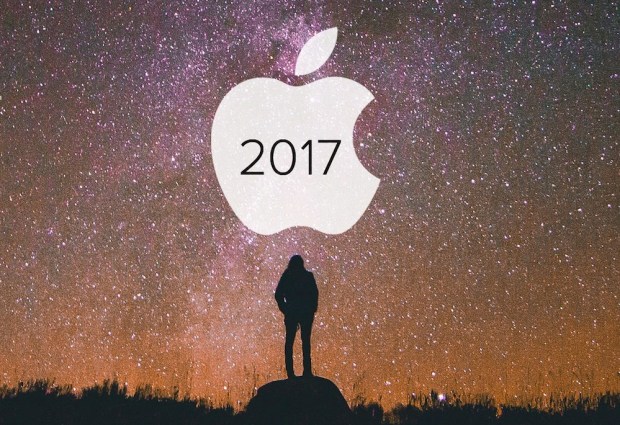Apple Closes In On $1 Trillion Market Cap

It’s hard to complain when more than one writer uses the phrase “minting cash” to describe a firm’s quarterly performance.
Yesterday, that was Apple, who managed to beat analyst estimates on every number that matters as its fiscal fourth-quarter numbers hit the wires. They also managed to surprise those analysts, since Apple was widely expected to post lackluster iPhone sales due to the somewhat unusual 2017 device rollout schedule.
In a normal year, the flagship phone is announced in September and goes on sale for the last week of the quarter, effectively boosting sales. This year, the new iPhone 8, which has been on the market since Sept. 22, is what drove Q4 sales. The actual flagship, the iPhone X, has only been available for pre-order business for a week.
“We’re happy to report a very strong finish to a great fiscal 2017, with record fourth quarter revenue, year-over-year growth for all our product categories, and our best quarter ever for services,” said Tim Cook, Apple’s CEO. “We’re looking forward to a great holiday season, and with the launch of iPhone X getting underway right now, we couldn’t be more excited as we begin to deliver our vision for the future with this stunning device.”
By The Numbers
Apple notched $52.6 billion in revenue in Q4, widely beating the $50.7 billion forecasted pre-release. Earnings per share were also higher than expected, at $2.07 as opposed to the $1.87 analysts were expecting.
The all-important figure – the iPhone unit sales – were the day’s least expected beat. After several weeks of media reports on weak sales figures for the iPhone 8 and 8 Plus, the numbers didn’t end up matching the doom and gloom. Analysts expected 46 million in unit sales, and 46.7 million units were sold.
iPad sales continued their rebound with 10.3 million units sold, up 11 percent from a year ago. The third quarter marked the first time iPad unit sales rose after 13 consecutive quarters of declines, and the rally has now extended into a second quarter.
That rally is tied to another, arguably more significant international Apple turnaround. Sales in China hit $9.8 billion, up 12 percent from a year ago, returning the segment to growth after a multi-quarter extended slump. Much of that growth was pushed by the resurgent iPads, as the tablets are popular in the Chinese and Southeast Asian markets.
India also notched some impressive growth: 39 percent year-over-year, according to Apple’s chief financial officer Luca Maestri.
Apple also noted that it sold 5.4 million Macs, a 10 percent pick-up from the same time in 2016.
Services once again achieved a new revenue record, with 34 percent year-over-year growth. This is the branch of the business that holds the App Store, Apple Music, iCloud, iTunes and Apple Pay. Sales of its “other products,” which include the Apple Watch, Air Pods, Beats headphones and other accessories, rose 36 percent to $3.2 billion.
As for next quarter, Apple is forecasting sales of $84 billion to $87 billion, mostly ahead of the $84.9 billion expected by Thomson Reuters.
A Very iPhone X Christmas
“You can see from our guidance, we’re very bullish,” Cook said on a conference call, noting Apple’s enthusiasm for getting the iPhone X out into the wild tomorrow.
Cook also noted that even Apple executives were surprised to see the iPhone 8 and 8 Plus quickly rise to become Apple’s two top-selling phone models. “That for us was a bit of a surprise,” he said. “A positive surprise, obviously.”
Cook did not, however, disclose the specific sales mixes.
And the enthusiasm for the X’s potential to deliver a big holiday result is not entirely unwarranted. Customers scooped up 125 percent more units in the first four days of pre-orders than the previous record holder, the iPhone 6. Analysts expect Apple will sell 81 million phones this holiday season, beating its previous 2014 record of 78 million.
But there are supply worries with the X, because of how quickly it sold out in pre-order (a delivery tomorrow means someone managed to order in the 10-minute window on day one, when it was possible to get one), and the current wait for an online order is five to six weeks.
Unsurprisingly, lines have started forming at Apple stores all over the world.
“I’m told we had several hundred people waiting in Sydney,” Cook said. “We’re getting similar reports across that region.”
On the upside, Cook did spend a fair amount of his call with analysts talking up the Apple Store redesign and its vision of building the “town square” of the future. It looks like they will have a captive audience at many locations tomorrow.
And Cook was positive – if a little vague – about the upcoming supply issue.
“The ramp for the iPhone X is going well, especially considering that the iPhone X is the most advanced iPhone we’ve ever created and it has lots of new technology in it,” he said. “So we’re really happy that we’re able to increase week by week what we’re outputting, and we’re going to get as many of them as possible to customers as soon as possible. I can’t predict at this point when that balance will happen.”
Probably not what the fanboys wanted to hear.
Apple Services got a call out as well. With $8.5 billion in revenue, the services bring in more money than Air Pods, Apple TV, Apple Watch and iPads, and is Apple’s second-largest revenue generator behind the iPhone.
Apple credits the continued growth to the expansion of Apple Music and cloud services, which grew by 75 percent this year (though they did not specify the accompanying hard numbers) and to the continued explosive growth in the App Store – which, Maestri noted, brings in twice the revenue of the Google Play store.
Even Apple Pay got a shout out, with some of service revenue growth attributed to the expansion of Apple Pay into new territory of late – specifically Denmark, Finland, Sweden and the UAE in the last month. Stateside, Apple has also been working with Safeway to support Apple Pay, with rollouts to all 912 stores in the U.S. currently underway.
Killer Stats
$900 Billion: Apple’s after-hours trading market cap
$268.9 billion: Apple’s cash and cash equivalents, up $7.3 billion from a year ago
$28.8 billion: Apple’s iPhone revenue during Q4, 55 percent of total revenue
$8.5 Billion: Revenue from services in Q4, a 34 percent increase from Q4 2016
81 million: The number of iPhone units expected to sell in the holiday quarter.
46.7 million: The number of iPhone units sold during Q4
